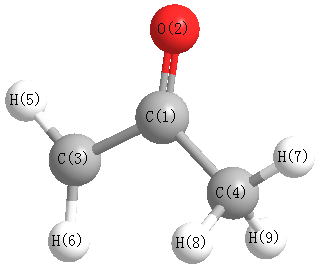Vibrational Frequencies calculated at QCISD(T)=FULL/6-31G*
| Mode Number |
Symmetry |
Frequency
(cm-1) |
Scaled Frequency
(cm-1) |
IR Intensities
(km mol-1) |
Raman Act
(Å4/u) |
Dep P |
Dep U |
|---|
| 1 |
A' |
3288 |
3288 |
|
|
|
|
| 2 |
A' |
3177 |
3177 |
|
|
|
|
| 3 |
A' |
3174 |
3174 |
|
|
|
|
| 4 |
A' |
3055 |
3055 |
|
|
|
|
| 5 |
A' |
1638 |
1638 |
|
|
|
|
| 6 |
A' |
1519 |
1519 |
|
|
|
|
| 7 |
A' |
1491 |
1491 |
|
|
|
|
| 8 |
A' |
1437 |
1437 |
|
|
|
|
| 9 |
A' |
1301 |
1301 |
|
|
|
|
| 10 |
A' |
1081 |
1081 |
|
|
|
|
| 11 |
A' |
945 |
945 |
|
|
|
|
| 12 |
A' |
836 |
836 |
|
|
|
|
| 13 |
A' |
525 |
525 |
|
|
|
|
| 14 |
A' |
384 |
384 |
|
|
|
|
| 15 |
A" |
3123 |
3123 |
|
|
|
|
| 16 |
A" |
1521 |
1521 |
|
|
|
|
| 17 |
A" |
1048 |
1048 |
|
|
|
|
| 18 |
A" |
690 |
690 |
|
|
|
|
| 19 |
A" |
501 |
501 |
|
|
|
|
| 20 |
A" |
352 |
352 |
|
|
|
|
| 21 |
A" |
93 |
93 |
|
|
|
|
Unscaled Zero Point Vibrational Energy (zpe) 15587.8 cm
-1
Scaled (by 1) Zero Point Vibrational Energy (zpe) 15587.8 cm
-1
See section
III.C.1 List or set vibrational scaling factors
to change the scale factors used here.
See section
III.C.2
Calculate a vibrational scaling factor for a given set of molecules
to determine the least squares best scaling factor.
